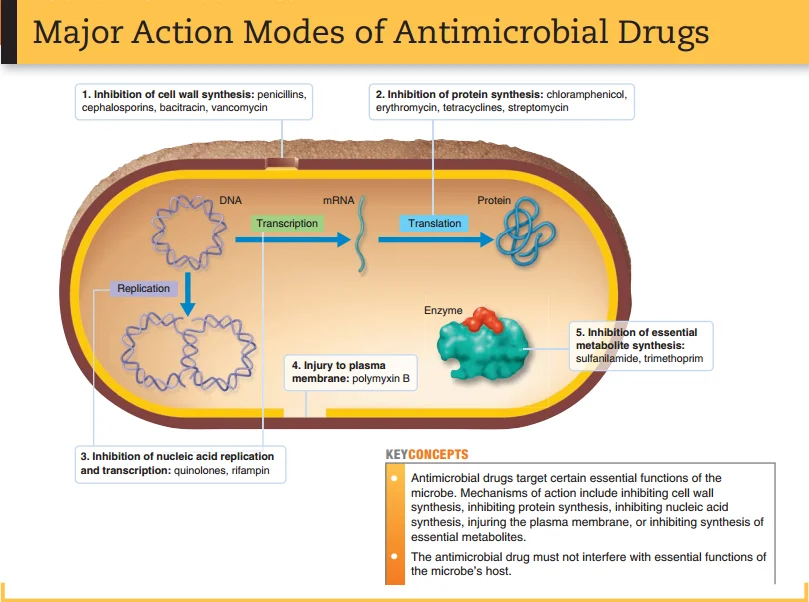Summary :
◉ What is an antibiotic ?
Antibiotic is any natural substance of biological origin produced by a living organism, chemical substance produced by synthesis or semi-synthetic substance obtained by chemical modification of a natural base molecule which is capable of inhibiting the multiplication or destroying microorganisms and having the following properties :
- Antibacterial activity (bacteriostatic or bactericidal)
- Activity in organic medium
- Moderate toxicity allowing systemic use
- Good absorption and good diffusion in the body
Antibiotics have the property of directly interfering with the proliferation of microorganisms at concentrations tolerated by the host.
❖ Bacteriostatic Antibiotic
- Stops the growth of bacteria by preventing their proliferation, thus facilitating their destruction by the host's defenses.
- Reversible effect
❖ Bactericidal Antibiotic:
- Kills bacteria, preferred in cases of severe infection and/or large inoculum and in immunocompromised patients.
- Irreversible effect.
◉ Classification of antibiotics
☰ La classification des antibiotiques peut se faire selon :
- Origin : Antibiotics can also be classified based on their source, such as natural antibiotics (produced by microorganisms), semi-synthetic antibiotics (modified from natural antibiotics), and synthetic antibiotics (made completely in the lab)
- Mode of action : Antibiotics can be grouped based on their mode of action, such as cell wall inhibitors, protein synthesis inhibitors, and nucleic acid inhibitors.
- Activity spectrum : They can be classified based on their spectrum of activity, which refers to the range of bacteria they are effective against. Broad-spectrum antibiotics are effective against a wide range of bacteria, while narrow-spectrum antibiotics are only effective against specific types of bacteria.
- Chemical structure : Very variable, it is often based on a basic structure (eg: β lactam ring) on which there is semi-synthesis. The classification according to the chemical nature allows us to classify the antibiotics into families (β lactams, aminoglycosides, tetracyclines…..etc.)
- Clinical use : Antibiotics can also be classified based on their clinical use, such as antibiotics used to treat respiratory infections, urinary tract infections, skin infections, and so on.
- Route of administration : Antibiotics can be classified based on how they are administered, such as orally, intravenously, or topically.
- Duration of action : Antibiotics can be classified based on how long their effects last in the body, such as short-acting, long-acting, or extended-release antibiotics.
◉ Mode of action of antibiotics
☰ Antibiotics act at the molecular level at the level of one or more metabolic steps essential to the life of the bacterium. They act by :
👉 Selective toxicity at the level of:
- Synthesis of the bacterial wall
- Cytoplasmic membrane
- Protein Synthesis
- Nucleic acids
👉 Competitive inhibition
In this case the antibiotic is a structural analog, it interferes with an essential function of the bacterium.

◉ Antibiotics Families
Some common families of antibiotics include :
- Beta-lactams : They work by inhibiting bacterial cell wall synthesis. This family of antibiotics includes penicillins, cephalosporins, and carbapenems.
- Macrolides : They work by inhibiting bacterial protein synthesis. This family of antibiotics includes erythromycin, azithromycin, and clarithromycin.
- Tetracyclines : They work by inhibiting bacterial protein synthesis. This family of antibiotics includes tetracycline, doxycycline, and minocycline.
- Aminoglycosides : They work by inhibiting bacterial protein synthesis. This family of antibiotics includes gentamicin, tobramycin, and amikacin.
- Fluoroquinolones : They work by inhibiting bacterial DNA synthesis. This family of antibiotics includes ciprofloxacin, levofloxacin, and moxifloxacin.
- Sulfonamides : They work by inhibiting bacterial folate synthesis. This family of antibiotics includes trimethoprim-sulfamethoxazole (also known as co-trimoxazole or TMP-SMX).
- Glycopeptides : They work by inhibiting bacterial cell wall synthesis. This family of antibiotics includes vancomycin and teicoplanin.
- Oxazolidinones : They work by inhibiting bacterial protein synthesis. This family of antibiotics includes linezolid.
- Streptogramins : This family of antibiotics includes quinupristin and dalfopristin.
- Polymyxins : This family of antibiotics includes colistin and polymyxin B.
- Nitrofurans : This family of antibiotics includes nitrofurantoin and furazolidone.
- Fusidane-type antibiotics : represented by fusidic acid, helvolic acid